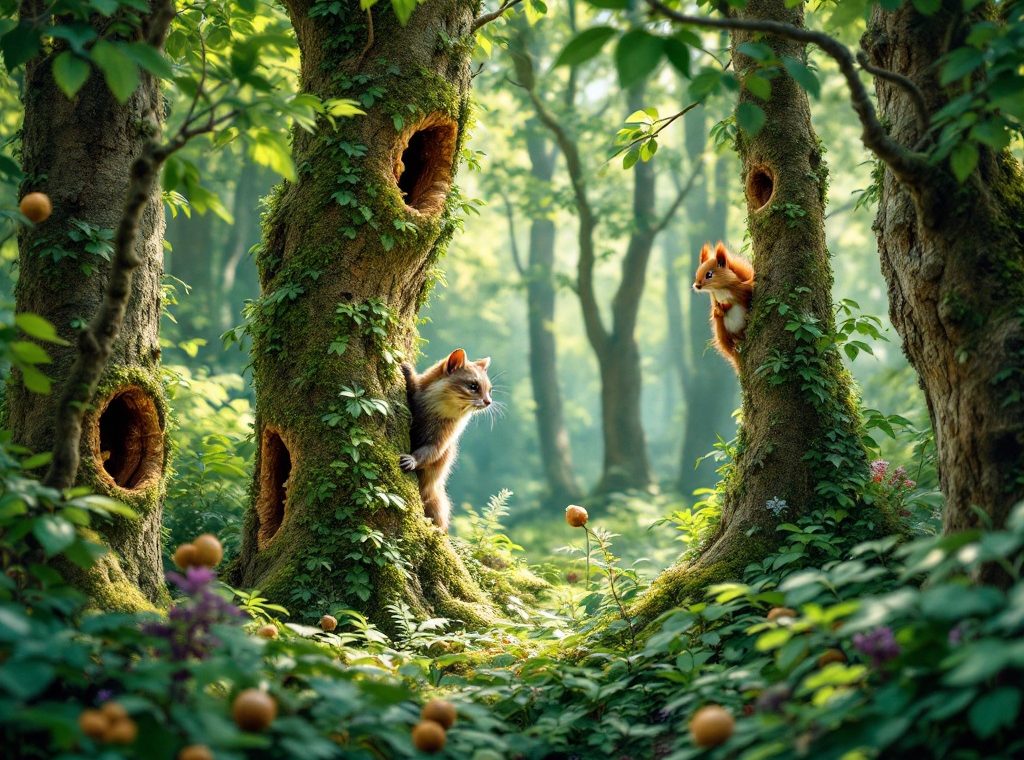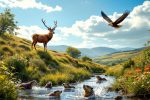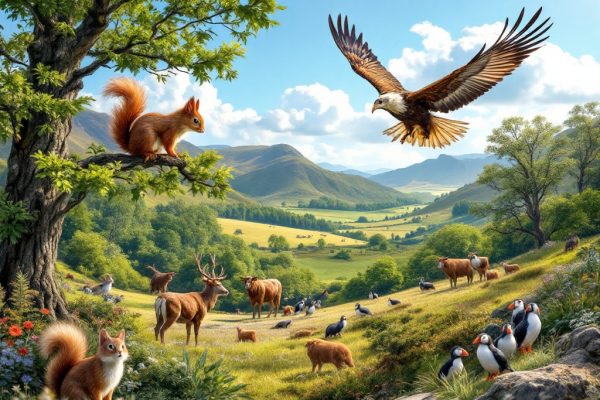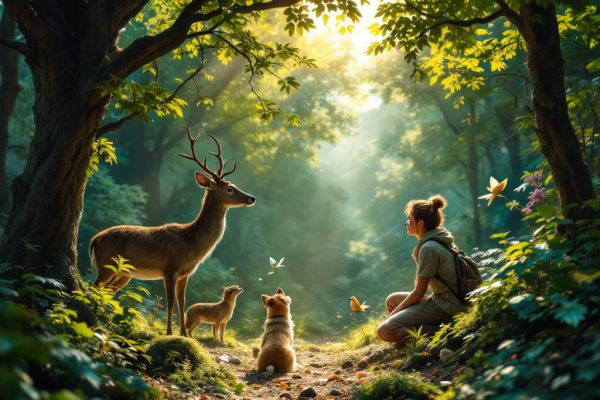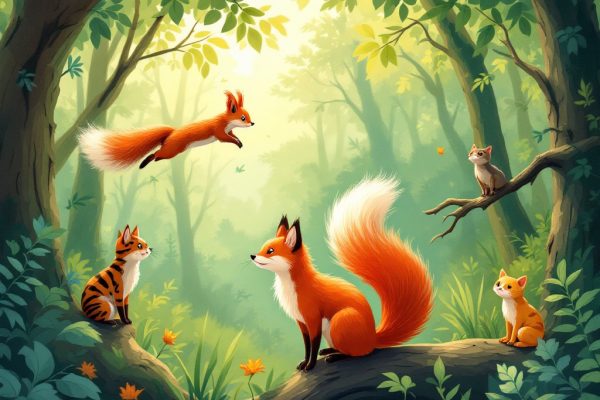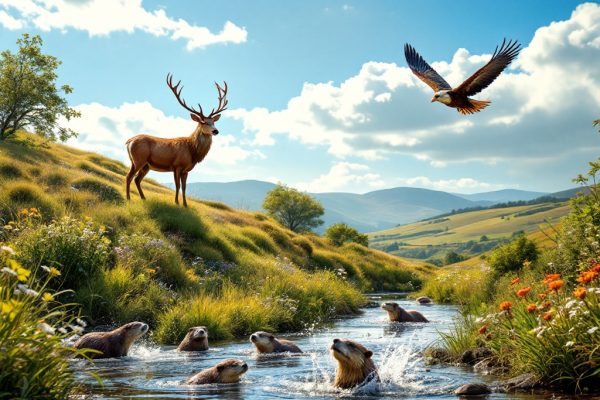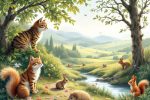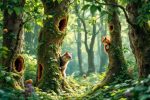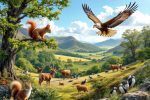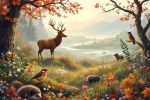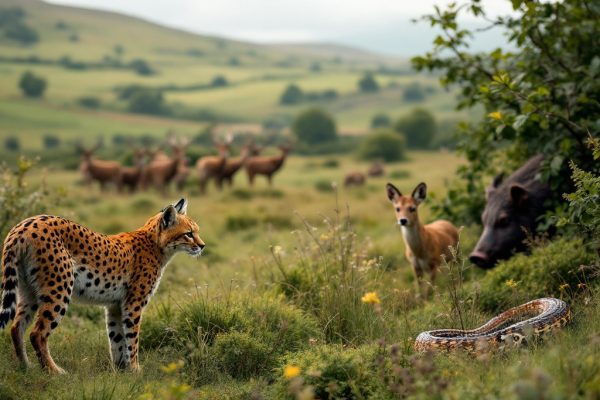Lothian Animals that Live in Trees
Discover the vibrant ecosystem thriving within Lothian’s trees! From agile pine martens and elusive Scottish wildcats to the charming red squirrel, a diverse array of wildlife depends on these arboreal havens. Explore the crucial role of tree cavities, breeding nests, and the unique adaptations of these fascinating creatures. Learn about the challenges they face, from habitat loss and climate change to invasive species, and discover how conservation efforts are working to protect them. Delve into the world of Lothian’s treetop dwellers and uncover how we can all contribute to their survival. Read on to explore this fascinating world!
Important information
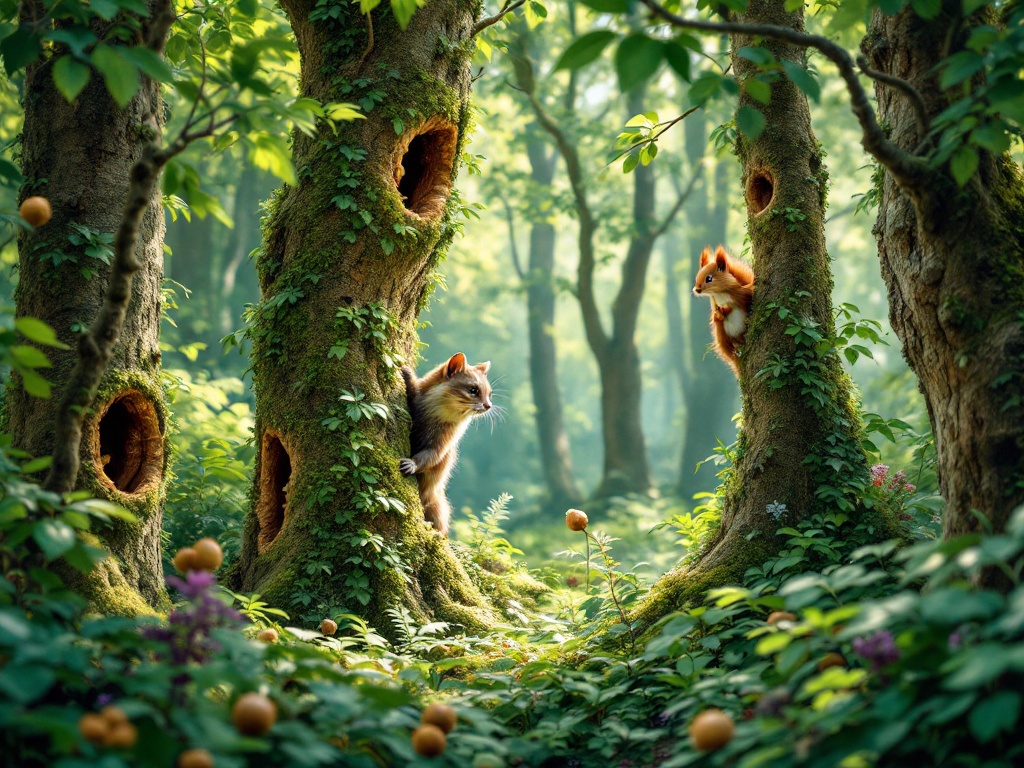
- Lothian’s trees support diverse wildlife like red squirrels, pine martens, hazel dormice, various birds, and insects, providing food, shelter, and nesting sites.
- Tree cavities and hollows are crucial habitats for nesting, roosting, and protection for animals like woodpeckers, owls, squirrels, bats, and insects.
- Red squirrels face threats from habitat loss, competition with grey squirrels, and the squirrelpox virus. Conservation efforts focus on habitat preservation and grey squirrel management.
- Habitat loss due to deforestation and urbanization, along with climate change and invasive species, are major challenges for tree-dwelling animals in Lothian.
- Protecting and restoring native woodlands and creating wildlife corridors are essential for the long-term survival and biodiversity of these species.
Lothian Animals that Live in Trees: An Overview
Lothian’s trees provide a vital habitat for a variety of wildlife. They offer shelter, food, and nesting sites for various species, contributing to a thriving ecosystem. Red squirrels, pine martens, and hazel dormice use these trees for shelter, food, and raising their young. Birds, such as woodpeckers, robins, and owls, nest in tree cavities, while bats roost in hollows. Insects like butterflies and beetles inhabit the foliage and bark, and the branches offer foraging opportunities for creatures like the red squirrel.
The Role of Trees in Supporting Diverse Wildlife
Lothian’s trees are essential for supporting a diverse range of wildlife. They provide shelter in their hollows for creatures like mammals and birds, while their leaves and branches offer sustenance for insects, which in turn become food for larger animals. The trees’ roots play a crucial role in preventing soil erosion, maintaining the forest’s overall health. Furthermore, the varied structures of these trees create a mosaic of microhabitats, enriching the biodiversity of Lothian’s woodlands.
Tree Cavities and Hollow Trees as Habitats
Tree cavities and hollow logs are essential havens for Lothian wildlife. Creatures like woodpeckers, owls, red squirrels, and bats utilize these natural shelters for nesting, roosting, and protection from predators. Even insects, such as caterpillars and beetles, depend on these hollows. These vital spaces play a crucial role in the health of the ecosystem.
- Woodpeckers excavate cavities, creating homes for themselves and other animals.
- Owls use these shelters for nesting and roosting.
- Red squirrels find refuge and safe spaces to raise their young.
- Bats use cavities for hibernation and daytime roosting.
- Insects, including caterpillars and beetles, depend on these hollows for shelter and food.
These natural shelters contribute significantly to the biodiversity and health of the Lothian ecosystem.
Breeding Nests and Territorial Behavior
Tree cavities offer essential shelter for raising young, acting as nests for animals like red squirrels and hazel dormice.
- These hollows protect inhabitants from predators,
- These hollows protect inhabitants from harsh weather.
Often territorial, tree dwellers use scent marking and calls to defend essential resources, such as food and nesting sites.
Territory size varies depending on the species and resource availability.
Tree-Dwelling Mammals in Lothian
Lothian’s woodlands provide a habitat for three captivating tree-dwelling mammals: the hazel dormouse, the Scottish wildcat, and the pine marten. Dormice are ideally suited to an arboreal life, building their nests and finding food within the tree canopy. Wildcats use the woodland for both refuge and hunting grounds. Likewise, pine martens depend on trees for creating dens and resting. The existence of these mammals underscores the essential role Lothian’s forests play in maintaining a rich variety of wildlife.
Hazel Dormouse: Habitat and Conservation Status
Hazel dormice thrive in leafy woodlands, hedgerows, and scrubland. As a European Protected Species, their survival depends on conservation efforts that manage and protect their habitat.
Scottish Wildcat: Dependency on Woodland
Scottish wildcats depend on woodland for survival, using it for shelter, hunting, and breeding. Large, undisturbed areas are particularly crucial, providing safe spaces to raise their young. Essentially, the more woodland available, the greater the chance these cats have to thrive.
Pine Martens: Key Characteristics and Habitat
Pine martens, known for their sharp teeth, are part of the mustelid family and have a diverse diet. These agile climbers are primarily found in trees. However, they need large territories, mostly in native woodlands, where they are essential for maintaining healthy forest ecosystems.
Physical Traits and Adaptations
Agile pine martens are natural climbers, effortlessly scaling trees with their sharp claws and strong limbs. As carnivores, their teeth are perfectly suited to their meat-based diet, featuring prominent canines and razor-sharp carnassials, ensuring their survival in the wild.
Habitat Preferences and Territorial Needs
Pine martens prefer woodlands, establishing territories ranging from 86 to 166 hectares. However, these adaptable creatures can also thrive in conifer plantations and on rocky hillsides.
Role in the Ecosystem and Diet
Pine martens are omnivores with a diverse diet. Their meals include small mammals such as voles, mice, squirrels, and rabbits, as well as birds, eggs, and insects. They also supplement their diet with fruit. As predators, they help control prey populations. Their consumption of fruit contributes to seed dispersal and forest regeneration.
Red Squirrels and Their Woodland Environment
Scottish red squirrels, easily identified by their prominent ear tufts, especially in winter, have fur that ranges from reddish-brown to gray, providing excellent camouflage among tree branches. Smaller than gray squirrels, they primarily eat pine cone seeds, supplementing their diet with buds, fungi, and fruits.Woodland is essential to their survival. It offers nesting sites high in the canopy. These nests, known as dreys, are constructed from twigs, leaves, and moss. The diverse woodland plants ensure a year-round food supply. The trees themselves act as safe pathways between feeding and nesting areas.
Challenges
- Competition with gray squirrels for resources.
- The deadly squirrelpox virus spread by gray squirrels.
- Habitat loss due to deforestation and fragmentation.
Conservation Efforts
- Controlling gray squirrel populations.
- Protecting and restoring woodland habitats.
- Raising public awareness.
Characteristics of the Scottish Red Squirrel
Scottish red squirrels are easily identified by their prominent ear tufts, particularly noticeable in winter. These striking tufts, along with their bushy tails, aid in balance and communication. Active during the day, these diurnal squirrels forage for a varied diet of seeds, nuts, fungi, and fruits.
Importance of Woodland for Survival
Scottish red squirrels rely on woodlands for their survival. These forests provide essential food sources, including nuts, seeds, fungi, and fruits. Trees also offer shelter; squirrels build nests, known as dreys, within the branches, using the dense foliage for protection from predators such as pine martens and goshawks. A healthy woodland directly impacts the squirrel population by ensuring ample food and safe breeding sites, allowing these vibrant creatures to thrive.
Threats and Conservation Efforts
Red squirrels face several serious threats, including habitat loss and competition from invasive grey squirrels. However, the biggest danger is the squirrelpox virus, carried by grey squirrels but fatal to the reds. While greys remain unaffected, the virus poses a significant threat to the vulnerable red squirrel population.
Protecting woodland habitats is crucial for red squirrel survival. Creating buffer zones, for example, can help. Managing grey squirrel populations is also essential, along with raising public awareness. People can contribute by reporting sightings and supporting conservation organizations.
- Protecting woodland habitats.
- Creating buffer zones.
- Managing grey squirrel populations.
- Raising public awareness.
- Reporting sightings.
- Supporting conservation organizations.
Birds and Insects: Vital Tree Residents
Lothian’s trees offer a sanctuary for diverse bird species. These include great tits, blue tits, and woodpeckers, which depend on the trees for nesting, foraging, and protection. Species such as owls, robins, and warblers also find refuge among the branches. A thriving insect community inhabits the upper canopy. Butterflies, beetles, and caterpillars pollinate the trees and sustain other creatures, while the bark provides them with shelter.
Common Tree-Dwelling Birds in Lothian
Lothian’s trees offer a sanctuary for a diverse array of birds. Common species like the great tit and blue tit share this habitat with the striking woodpecker, owls, robins, and warblers. These birds rely on trees for essential needs. Trees provide nesting sites, foraging grounds, and protective shelter. For example, woodpeckers use their strong beaks to extract insects from the bark. Owls utilize tree cavities for nesting and roosting. Robins and warblers prefer to build nests within the branches and forage for food amongst the foliage. This rich arboreal environment supports Lothian’s vibrant birdlife.
Insect Life Among Tree Canopies
Tree canopies are teeming with insect life, which boosts biodiversity and provides a vital food source for birds. These insects, including beetles, caterpillars, and aphids, also play a crucial role in decomposition. The canopy’s leaves and branches offer them both sustenance and shelter.
Challenges Facing Tree-Dwelling Species
Habitat loss due to deforestation and urban development poses a severe threat to Lothian’s tree-dwelling animals. Pollution further endangers these creatures by contaminating their food sources and nesting sites.
The changing climate disrupts established weather patterns and food availability, adding another layer of difficulty. Invasive species compete with native animals for resources, upsetting the delicate balance of the ecosystem. Widespread pesticide use kills insects, impacting the food chain and further jeopardizing the survival of these arboreal inhabitants.
Impact of Human Activity and Habitat Loss
Lothian’s woodlands are vanishing due to deforestation and urbanization, jeopardizing the survival of tree-dwelling creatures. Red squirrels, pine martens, and hazel dormice are losing their homes and vital food sources. The dwindling resources and shelter pose a significant threat. However, conservation efforts offer a beacon of hope. Protecting remaining woodlands and restoring lost habitats are essential to mitigating the devastating impacts of habitat loss and ensuring the survival of Lothian’s arboreal wildlife.
Climate Change and Its Effects on Woodland Species
Climate change significantly impacts Lothian’s woodland creatures due to shifting temperatures and rainfall patterns. Vulnerable species like the red squirrel and pine marten rely on stable environments, which are disrupted by climate change. Altered temperatures also affect plant growth cycles, creating a potential mismatch between food availability and animal needs. This poses a growing challenge to these woodland species.
Coexisting with Tree-Dwelling Wildlife
Wildlife hides and observation points offer a unique way to observe animals undisturbed, preserving their natural behaviors. Protecting existing trees and planting new ones ensures the long-term survival of many creatures.
- protecting native woodlands and ancient forests is crucial, as these areas provide essential habitats where species can thrive,
- local communities play a vital role, and education and conservation initiatives empower them to make a real difference.
Maintaining green spaces and creating wildlife corridors are also important. These corridors connect fragmented habitats, enabling animals to move freely and safely, which in turn supports biodiversity.
Creating Nature Hides and Observation Points
Building a wildlife hide near trees maximizes your chances of observing animals in their natural habitat. An elevated platform provides a better vantage point for spotting creatures in the canopy. Constructing the hide with natural materials like wood and camouflaging it allows it to blend seamlessly with the surroundings. Positioning the hide downwind is essential to prevent animals from detecting your scent, minimizing disturbances and maximizing your viewing opportunities.
Promoting Native Woodlands and Ancient Forests
Restoring old forests and native woodlands benefits tree-dwelling animals and boosts biodiversity. Protecting these habitats is vital, as is creating wildlife corridors to connect them. This helps preserve biodiversity by enabling animals to move between habitats, find mates, and access resources. These conservation efforts improve ecosystem health and help specialized species survive for the long term. Connecting fragmented habitats promotes gene flow, which strengthens populations against environmental changes.

